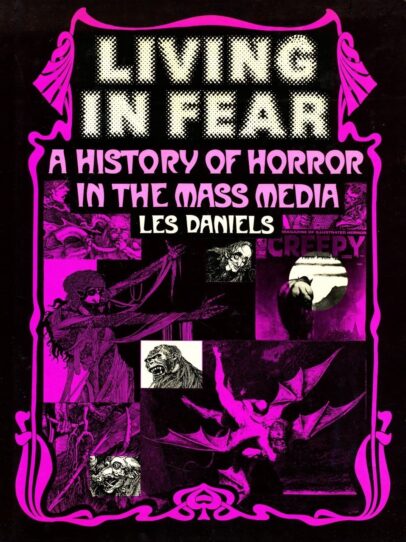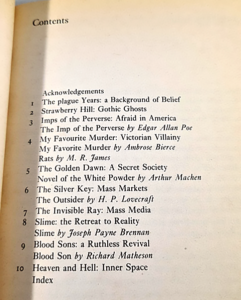 By LES DANIELS (Charles Scribner’s Sons; 1975)
By LES DANIELS (Charles Scribner’s Sons; 1975)
In a 1995 issue of NECROFILE the late Les Daniels (1943-2011) took the widely respected Phil Hardy edited OVERLOOK FILM ENCYCLOPEDIA: HORROR to task. Daniels, among other things, claimed Hardy was insufficiently knowledgeable about the genre (“he’s just somebody who got a package deal to produce several books, and then hired other people to do the actual writing”) and that his contributors had “taken too many courses in psych and semiotics.” When a reader wrote in to a subsequent issue to protest the review Daniels responded with a further volley of anti-Hardy insults, and concluded with the proclamation that horror, “a noble tradition…that extends to the grave and beyond,” is “under attack from knaves and fools, and I trust that most readers of this journal will join me in deploring Phil Hardy’s cheap, glib, hypocritical cant.”
For context on the above, read Daniels’ 1975 large format hardcover LIVING IN FEAR: A HISTORY OF HORROR IN THE MASS MEDIA. It explains both the jealousy that tinged his rants (as LIVING IN FEAR received a fraction of the attention lavished on Hardy’s tome) and his passionate defense of the genre.
It explains both the jealousy that tinged his rants (as LIVING IN FEAR received a fraction of the attention lavished on Hardy’s tome) and his passionate defense of the genre.
Daniels, curmudgeonly though he was, would go on to pen many more historical overviews (including the indispensable BATMAN: THE COMPLETE HISTORY), and his skills were adequately forecast in LIVING IN FEAR. Its coverage of (nearly) all things horror is admirably thorough and wide-ranging, with copious black and white illustrations, several stories by the authors Daniels mentions and voluminous info on the roots of what we now term horror.
Those roots, Daniels argues, can be found in the ORESTEIA of Aeschylus and THE ODYSSEY, which were succeeded by more concentrated horrific narratives like BEOWULF, DOCTOR FAUSTUS and TITUS ANDRONICUS. There followed THE CASTLE OF OTRANTO, which initiated the gothic fiction craze of Eighteenth Century England, the most famous exponent of which was Mary Shelley’s FRANKENSTEIN. There followed the work of Edgar Allan Poe, whose tale “The Imp of the Perverse” in included in its entirety.
Daniels also profiles important horror scribes like Ambrose Bierce, Bram Stoker (whose tale “My Favorite Murder” is included), Arthur Machen (occasioning a reprinting of “Novel of the White Powder”), and H.P. Lovecraft (represented by the inclusion of “The Outsider”) and his WEIRD TALES cohorts. Horror cinema is likewise given its due, with THE CABINET OF DR. CALIGARI getting a detailed airing, and also the 1925 PHANTOM OF THE OPERA, the Universal horror films of the 1930s, the subtle horror fests of Val Lewton and the much franker Hammer House of Horror films. There are also dissertations on horror in comics (Daniels had already penned a comic book history and so knew the terrain quite well), magazines and music.
Daniels’ critical verdicts are, as expected, not always positive. He says of Fritz Lang’s METROPOLIS that it “pleases the eye more than the intellect,” takes Val Lewton to task for turning out “halfhearted attempts, more respectable than entertaining,” and dismisses THE CREATURE FROM THE BLACK LAGOON as a “rather ordinary little film, directed in pedestrian style by Jack Arnold.”
Daniels’ critical verdicts are, as expected, not always positive.
Subjects that could have stood to be more thoroughly investigated include the horror pulps, which are given an extremely cursory overview, as well as horror literature by non-English speaking authors like Petrus Borel, Jean Ray, Claude Seignolle and Edogawa Rampo, all of whom go unmentioned (and all of whom had books available in English translation when Les Daniels wrote LIVING IN FEAR). Likewise, foreign film auteurs like Georges Franju, Nabuo Nakagawa, Masaki Kobayashi and Janusz Majewski are deserving of a bit more ink than the amount they receive here, which is none whatsoever.

